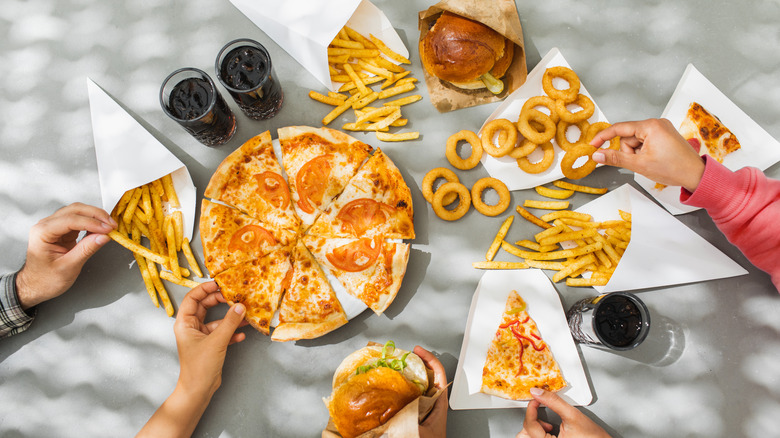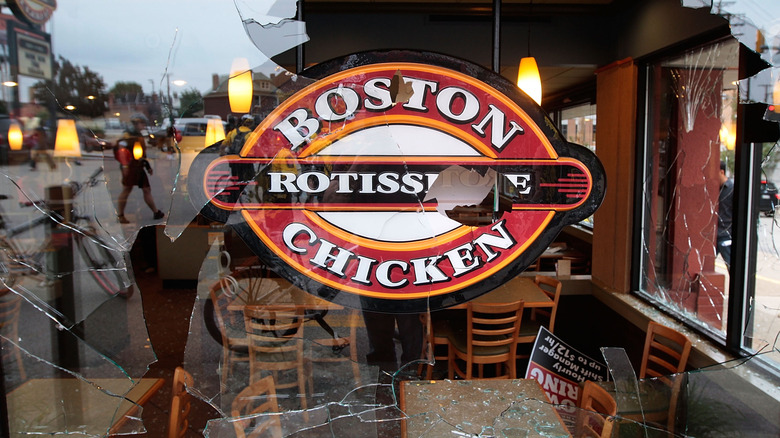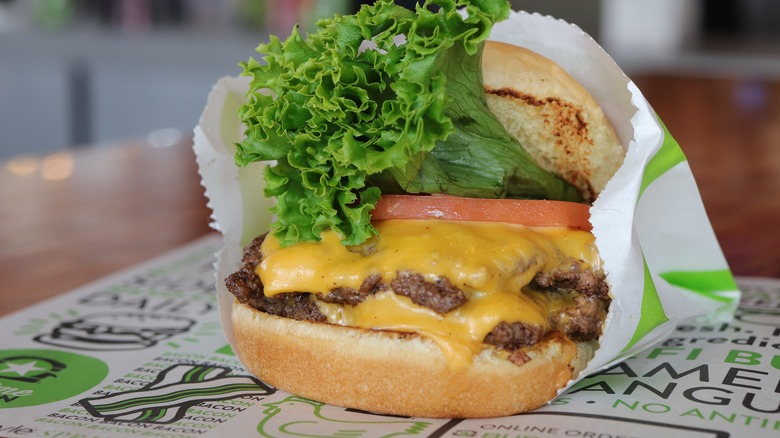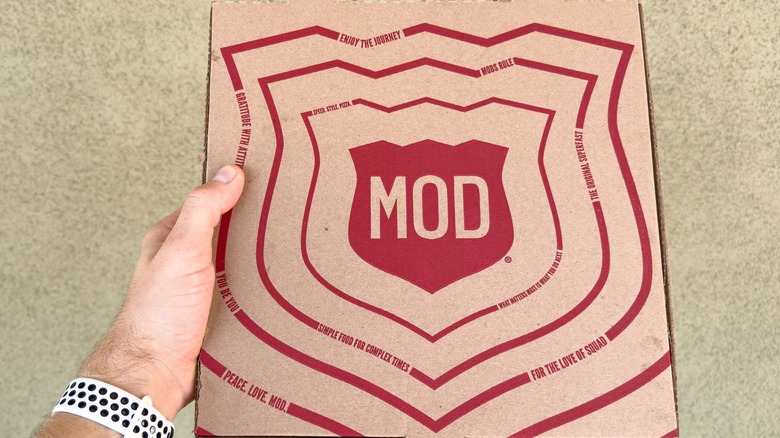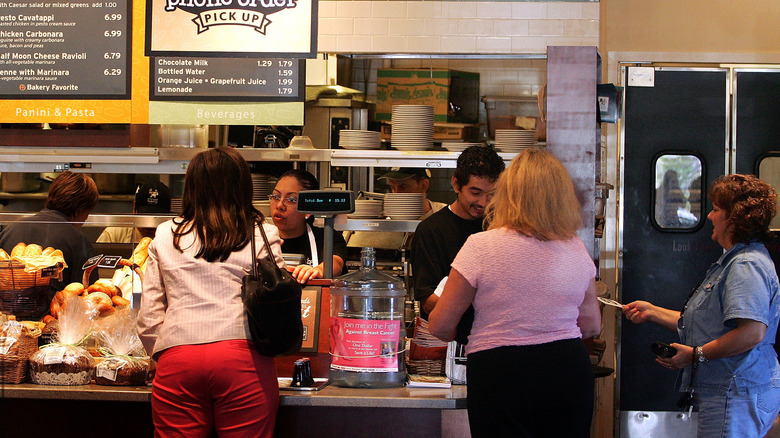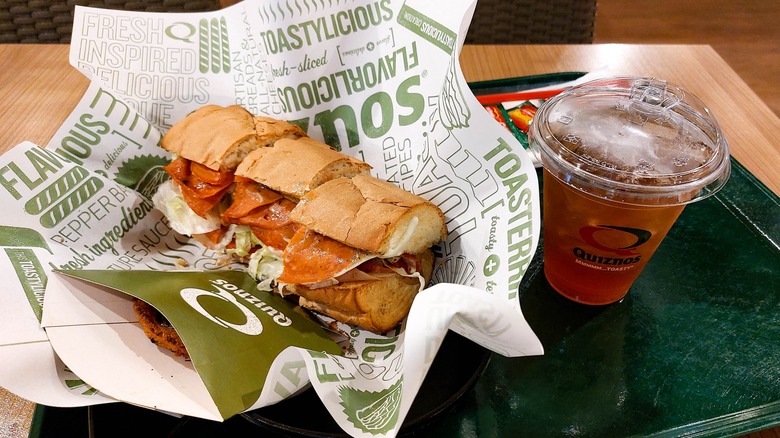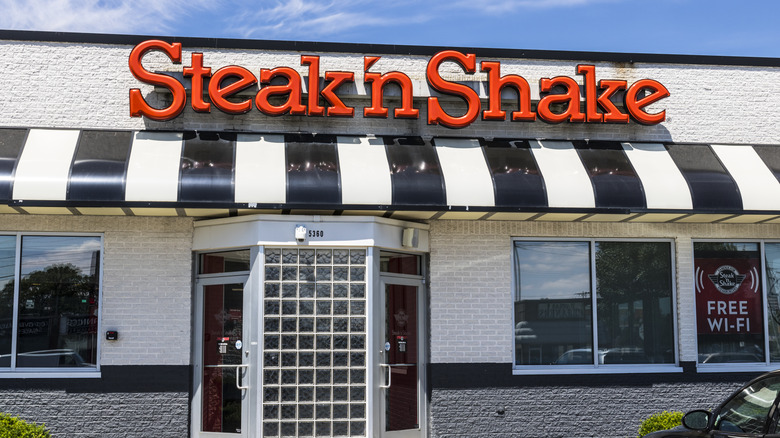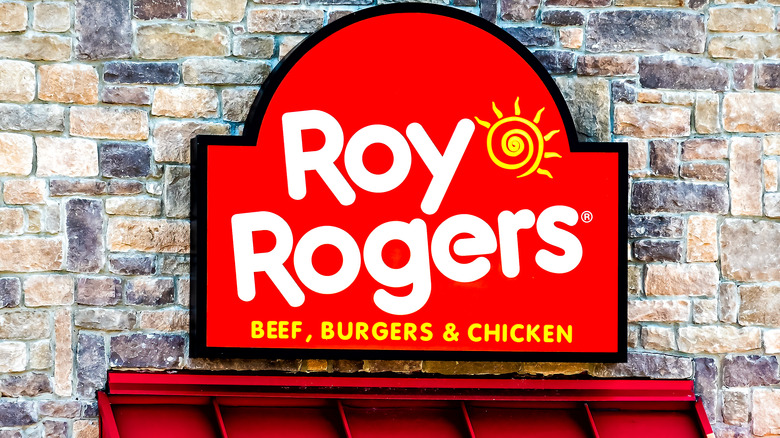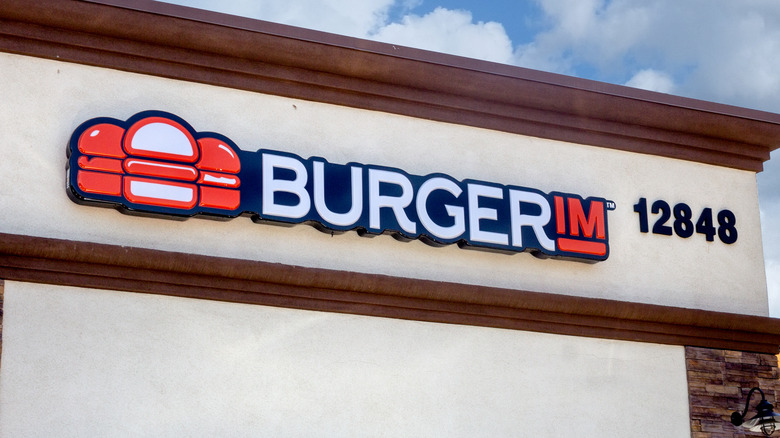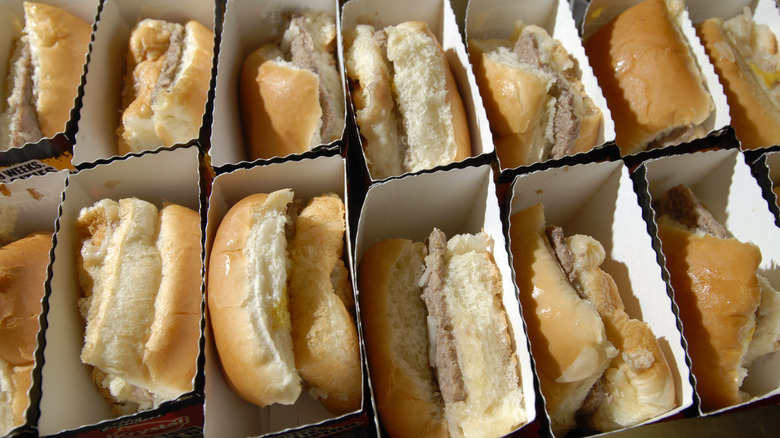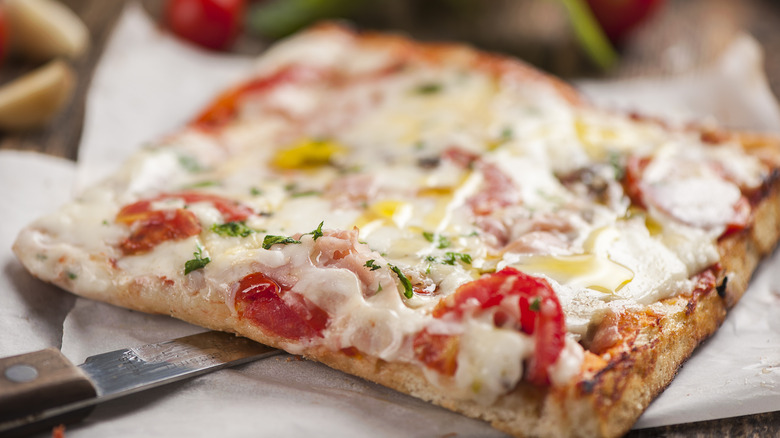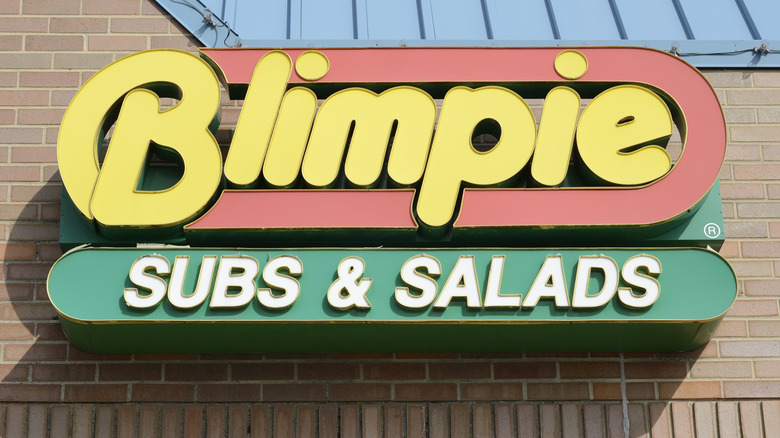Fast Food Chains That Could Go Bankrupt In 2024
Fast food dominates American culinary culture. Tasty, filling offerings like burgers, fries, pizza, and tacos are pretty much universally popular, and if they're served up remarkably fast and cheap, and if they don't require you to leave your car (or even your home), it's easy to see why. Historically, the fast food restaurants that hit it big will expand, eventually covering the country or globe with hundreds or thousands of outlets that are either company-owned or operated by franchisees. Dozens of these restaurants are household names, and they bring in paying customers every day, year after year.
But just because a company establishes a decades-long foothold in the competitive and cutthroat world of fast food business doesn't mean it will be around forever. As often as new and interesting chains arrive, there are always a few on the brink of collapse. Many fast food chains are closing stores in 2024, while other once-popular, once-profitable restaurants are dying a slow death — and may just go out of business (or at least file for bankruptcy) sometime this year. Some of the restaurants included in this list have already begun proceedings to restructure debt in 2024, while it remains to be seen if others are only closing locations — or are looking out over the brink of financial insolvency.
Boston Market
Until the 1990s, Boston Market was a major fast food establishment by offering approximations of old-fashioned family dinner favorites like mashed potatoes, macaroni and cheese, rotisserie chicken, and meatloaf (which some people think is terrible). But then, the chain — once known as Boston Chicken — tried to expand too far, too quickly.
After becoming a publicly traded company and bringing in millions with its stock IPO in 1993, Boston Market's corporate office issued loans to its top, multi-unit franchisees so that they could open multiple new stores all at the same time. At first, all those new stores generated massive profits for the franchisees and the Boston Market parent company, triggering more expansion. But then, the novelty of fast food meatloaf wore off, and the brand's over-saturation eventually had a negative effect. Financial problems led to widespread store closures — by 2015, the once 1,100-store chain only had around 460 locations.
A menu reboot did little to bring in new customers, and a 2020 acquisition by a private equity firm didn't turn things around, either. After it was named one of the fastest-shrinking restaurant chains of 2022, only 285 Boston Market restaurants remained the following year. Another year later, just 27 locations remain, with some outlets reporting that the corporate office has stopped sending them ingredients and supplies.
BurgerFi
In 2011, BurgerFi entered the ever-growing fast food niche of burgers and fries made with top-quality ingredients that are geared toward a more mature crowd, competing with the likes of Shake Shack and Five Guys. Over the next decade, the chain grew to include a total of more than 160 locations serving antibiotic-free burgers.
Then, the pandemic hit in 2020. Shutdowns designed to slow the virus' spread shuffled millions of people into work-from-home situations. This sudden loss of business proved financially catastrophic for BurgerFi — its locations operated primarily in high-traffic office areas, and when those workplaces closed up, the restaurants' customer base disappeared. The chains that did weather pandemic-era challenges did so because they transitioned to models centered on delivery and takeout. BurgerFi didn't have such a structure in place, and as a result, it lost out on potential revenue.
In June 2024, BurgerFi hired Kroll Securities to serve in a financial advisory capacity so the brand could pivot to a new business model and hopefully stave off closure. It has also taken out loans of $2 million at a time. If the company can't drum up enough business to pay all that back, it's feasible that its lenders, Trew Capital Management, could acquire BurgerFi and its sibling chain, Anthony's Coal-Fired Pizza.
MOD Pizza
One of several like-minded chains of the 21st century, MOD simplified the pizza-buying experience. MOD customers can order an individual or a family size pizza and pile it high with as many toppings as they like while it's made in front of them in an assembly line setup, like at Chipotle or Subway, and then it's flash-baked in just a few minutes.
After entering the fast food scene in 2008, MOD rapidly and steadily grew. By 2023, it consisted of 553 restaurants with revenues of $699 million, and both of these figures were up from 2022. Once one of the two fastest-growing restaurant chains in the U.S., things abruptly went downhill for MOD in 2024 when cofounder and CEO Scott Svenson left the company amidst the sudden closure of over 20 locations. In July 2024, MOD announced that it was in the early stages of a potential bankruptcy filing. To avoid that financially catastrophic move, the chain has brought on lawyers and financial experts to help it find a buyer to salvage MOD. After MOD was on the market for less than two weeks, Elite Restaurant Group, a company that specializes in buying and trying to save eateries on the brink of closing, purchased the whole pizzeria chain.
Corner Bakery Café
It's right there in the name — Corner Bakery Café sought to institutionalize the idea of a local, low-key corner café, selling sandwiches, treats, and coffee to customers of strip malls and people who worked in nearby office complexes. Created in 1991 and once considered a competitor of Panera or Starbucks, Corner Bakery Café grew into a network of 182 mostly franchised locations by 2019.
The pandemic — including lockdowns, shutdowns, and the mass migration of office workers to their homes — proved devastating to Corner Bakery Café. Without office workers to buy its products, revenues plummeted. In 2020, parent company Roark Capital sold Corner Bakery Café to franchised restaurant veteran Jay Pandya. Under his management, the chain couldn't and didn't pay its bills, and unhappy vendors filed suit more than 80 times to attempt to recoup what they were owed.
In 2022, banking giant Goldman Sachs found the company guilty of default on $43 million of loan payments. Restaurant operator SSCP Management bought the debt, declared bankruptcy for the restaurant, and converted its acquisition into ownership. Still, merely 100 cafés remain open in 2024 under what's still a tenuous new direction.
Quiznos
Created in the early 1980s, Quiznos could never quite overtake its most direct competitor in the sandwich sector, Subway. However, it carved out a niche and earned big money from a high of just around 5,000 restaurants by selling something different than all those other sub chains: hot, melty, rapidly-toasted sandwiches. And yet, Quiznos has been on death watch since around 2007. Losing a significant amount of its customer base when the Great Recession left too many office workers unemployed, Quiznos was also hit hard by increased competition from similar, slightly elevated fast food places like Chipotle and Five Guys.
By 2017, about 90% of all Quiznos restaurants had closed (via Distractify). Within four years, those 500 restaurants became 300, with sales figure percentages in double-digit decline. Rego Restaurant Group, with a financial assist from High Bluff Capital Partners, bought it all in 2019, looking to turn around the fading chain. The new owners brought in overhaul consultant Prophet, which recommended and helped enact a number of theoretical improvements. Stores were remodeled, with drive-throughs added to cater to customer trends and demand, and Quiznos got its first new logo in 20 years. In 2021, Quiznos announced that it would accept Bitcoin as payment and proposed a plan to move into ghost kitchens, a concept now on the verge of collapse. Those measures aren't working, however — as of 2024, just 148 Quiznos are left.
Steak 'n Shake
There are a lot of restaurant chains in the U.S. with a menu built around hamburgers and milkshakes. But Steak 'n Shake is one of a few that serves burgers made from several types of premium steak ground together, with hand-dipped, super-thick milkshakes always presented with a cherry on top. Taking inspiration from old-fashioned malt shops but serving the kind of high-quality burgers in demand in the 21st century, Steak 'n Shake did very well for itself, opening more than 620 outlets in the United States by 2019.
And then the descent began. In 2019, just over 100 outlets were temporarily shut down, followed by about 80 permanent closures in 2020. At one point, the situation was so serious that Steak 'n Steak was looking everywhere to save money and nearly dropped those cherries from the shakes because it would've saved $1 million a year. The company was reportedly ready to file for bankruptcy in 2021 until it was saved by Biglari Holdings, which stepped in to pay off the chain's substantial debt. That looked to be a temporary solution — after steadily losing more and more locations, by 2024, the formerly 600-restaurant chain boasted just over 400 restaurants.
Roy Rogers
Movie star and singing cowboy Roy Rogers didn't have much to do with the creation of the former fast food giant that bore his name. He was paid a licensing fee and agreed to make public appearances at outlets in the food service company created by the Marriott Corporation. After opening its first restaurant in Falls Church Virginia, in 1968, Roy Rogers grew quickly over the next two decades, topping out with nearly 650 restaurants, most of them in the northeastern U.S. and mid-Atlantic region.
In 1990, shortly after growing to as big of a chain as it would ever be, Hardee's bought out the Roy Rogers brand name. Over the next few years, that chain converted dozens of old restaurants into Hardee's, while other burger chains acquired, absorbed, and revamped, pre-existing Roy Rogers. By 2002, scarcely 60 Roy Rogers were left intact, and that number plummeted to just over 40 by 2023, all still selling something for everyone from its patchwork menu of hamburgers, fried chicken, and roast beef sandwiches.
But the company seems intent on surviving and even growing. In the 2020s, it launched a long overdue plan to overhaul the look of what restaurants remain, installing electronic menu boards, more drive-through windows, and testing out an ordering app, all innovations that other fast food chains adopted years ago. Meanwhile, Roy Rogers locations keep closing. As of 2024, there are 37 still going.
BurgerIM
"BurgerIM" comes from burgerim," Hebrew for "many burgers." Founder Donna Tuchner is an Israeli-born, American-trained chef, and she opened the first entry in her hamburger chain in Tel Aviv, Israel, in 2011. What differentiated BurgerIM from competitors: the burgers were small, sold in pairs, and available in as many as 10 quality proteins, including Wagyu beef and lamb (which is underrepresented in fast food), served on brioche sesame seed buns and topped with a host of quirky condiments such as avocado and pineapple. Entrepreneur Oren Loni bought into the novel formula and secured the franchise rights, and by 2016 nearly 200 BurgerIM locations were open or about to open.
BurgerIM became one of the hottest new restaurants around, and in the company's attempt to reach as many customers and make as much money as possible, it expanded too quickly. By 2019, more than 1,200 franchising agreements were in place. BurgerIM couldn't sustain all that growth at that point, and that same year it filed for bankruptcy. Adding to the bad news: BurgerIM franchisees led a suit against the corporate office, alleging dishonest contract practices. Settling the suit in 2021 cost BurgerIM $57 million at a time when it was down to about 125 locations. Loni was barred from ever franchising restaurants in the U.S. again. BurgerIM still operates upwards of 100 restaurants, while it has listed dozens of outlets as "temporarily closed," a distress signal of a company in decline.
Krystal
One of the first ever Southern fast food chains, Krystal got going in Tennessee in 1932 and regularly attracted millions of customers for 70 years with a distinctive menu. Krystal specializes in tiny, slider-style hamburgers, but also serves tiny chicken sandwiches, tiny hot dogs, tiny corn dogs, and large breakfast platters.
The purveyor of little burgers had very big money problems throughout 2019, to the point where it had to close 44 locations. That didn't quite fix things, and Krystal filed for chapter 11 bankruptcy protection in January 2020. Just under 300 restaurants were still operational at the time, and by May 2020, it looked like the financial problems were a thing of the past, as equity firm Fortress Investments purchased the entire enterprise for $49 million. Four years later, and despite cash infusions from new owners available, Krystal kept falling. By 2024, five more Krystal restaurants have shut down, and the growth and expansion promised by Fortress Investments at the time of its acquisition are yet to come to pass.
Cosi
Most American fast food chains start in the U.S., but not Cosi, a flatbread sandwich and pizza joint founded in Paris in the 1980s. When it moved into North America in the 1990s, it set itself apart from all the other sandwich shops and pizza parlors by playing up an elegant, upscale European tone. Cosi never really threatened the likes of Subway or Pizza Hut, however, as it faced financial problems for most of its American history, losing money every year from 1998 to 2015. An almost inevitable bankruptcy filing took place in 2016 and the chain was rescued by a private ownership group. That didn't help Cosi recover, and more and more outlets closed down until 2020 when the restaurant went up for sale.
Così filed for bankruptcy again in 2020, but planned to save itself by switching its business plan from a public-facing restaurant chain into a catering service. Meanwhile, the retail wing of Cosi continues to slowly die. What was once a 151 store-strong chain was down to just 14 spots by 2024.
Blimpie
The sub is the most American of sandwiches, and Blimpie has been selling them since 1964, when it was just a single shop in Hoboken, New Jersey, in 1964. About three decades later, it enjoyed tremendous growth. The chain, selling simple meat-and-cheese sandwiches, salads, chips, and drinks, opened new outlets at a rate of 1.5 per day in 1995, and by 2001, Blimpie operated more than 1,850 shops with $300 million in annual sales. The fall of Blimpie came just as fast. In 2002, co-founder Tony Conza sold a controlling share of Blimpie for around $30 million to franchisee Jeffrey Endervelt and a private investment group, and within four years a few hundred locations shut down. The closures continued after a sale to Kahala Restaurant Franchising in 2006, which oversaw the demise of a quarter of all remaining Blimpies.
People just weren't buying enough Blimpie sandwiches anymore, across the board — revenues fell by more than 75%, and between 2001 and 2015, nearly half of all franchisees who secured a Small Business Administration Loan to open their shop defaulted on their loan. By 2023, 200 Blimpies were left, and by 2024, just about 100 are open.
